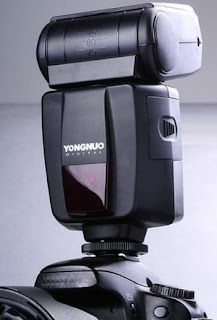
Look for the Classic Lighting Patterns
While the classic lighting patterns do not have to be used with absolute precision, it is essential to know what they are and how to achieve them. If, for instance, you are photographing your bride and groom outdoors, you can position a single main light to produce the desired lighting pattern and ratio, and use the ambient light (shade, or sun as back lighting) as the fill light. No other lights are needed to produce any of the five basic portrait set-up. Use of reflectors, instead of an independent fill light or kickers, may accomplish much the same results in terms of controlling light. Basically, however, each of the lighting patterns takes its personality from the placement
of the main light, so this is the most important source to consider.
Paramount Lighting. In Paramount lighting, sometimes called butterfly lighting or glamour lighting, the main light is placed high and directly in front of the face. This gives a symmetrical, butterfly shaped shadow directly beneath the subject’s nose, it also tends to emphasize cheekbones and good skin. The fill light is placed at the subject’s head height directly under the main light. Since both the main and fill lights are on the same side of the camera, a reflector is used on the opposite of the subject to fill in the deep shadows on the neck and shaded cheek. The hair light is used opposite the main light and placed so that it does not skim onto the face of the subject. The background light (if used) should be low and behind the subject, forming a semi circle of illumination background.
Loop Lighting. Loop lighting is a minor variation of Paramount lighting and is ideal for people with average, oval shaped faces. The main light is lowered and moved more to the side of the subject so that the shadow under the nose becomes a small loop on the shadow side of the face. The fill light is placed on the opposite side of the camera from the main light, close to the camera lens. (Note: Be sure to evaluate this from the camera position, making sure the fill light does not cast a shadow of its own.) In loop lighting, the hair light and background lights are used the same way they are in Paramount lighting.
0 comments:
Post a Comment